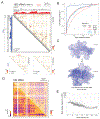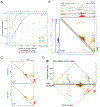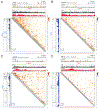Higher-Order Organization Principles of Pre-translational mRNPs
- PMID: 30415953
- PMCID: PMC6239896
- DOI: 10.1016/j.molcel.2018.09.012
Higher-Order Organization Principles of Pre-translational mRNPs
Abstract
Compared to noncoding RNAs (ncRNAs), such as rRNAs and ribozymes, for which high-resolution structures abound, little is known about the tertiary structures of mRNAs. In eukaryotic cells, newly made mRNAs are packaged with proteins in highly compacted mRNA particles (mRNPs), but the manner of this mRNA compaction is unknown. Here, we developed and implemented RIPPLiT (RNA immunoprecipitation and proximity ligation in tandem), a transcriptome-wide method for probing the 3D conformations of RNAs stably associated with defined proteins, in this case, exon junction complex (EJC) core factors. EJCs multimerize with other mRNP components to form megadalton-sized complexes that protect large swaths of newly synthesized mRNAs from endonuclease digestion. Unlike ncRNPs, wherein strong locus-specific structures predominate, mRNPs behave more like flexible polymers. Polymer analysis of proximity ligation data for hundreds of mRNA species demonstrates that nascent and pre-translational mammalian mRNAs are compacted by their associated proteins into linear rod-like structures.
Keywords: ChimeraTie; RIPPLiT; exon-junction complex; mRNA; mRNP structure; proximity ligation.
Copyright © 2018 Elsevier Inc. All rights reserved.
Figures






Comment in
-
Re-viewing the 3D Organization of mRNPs.Mol Cell. 2018 Nov 15;72(4):603-605. doi: 10.1016/j.molcel.2018.10.044. Mol Cell. 2018. PMID: 30444995
References
-
- Andersen CB, Ballut L, Johansen JS, Chamieh H, Nielsen KH, Oliveira CL, Pedersen JS, Seraphin B, Le Hir H, and Andersen GR (2006). Structure of the exon junction core complex with a trapped DEAD-box ATPase bound to RNA. Science 313, 1968–1972. - PubMed
-
- Aw JG, Shen Y, Wilm A, Sun M, Lim XN, Boon KL, Tapsin S, Chan YS, Tan CP, Sim AY, et al. (2016). In Vivo Mapping of Eukaryotic RNA Interactomes Reveals Principles of Higher-Order Organization and Regulation. Mol Cell 62, 603–617. - PubMed
Publication types
MeSH terms
Substances
Grants and funding
LinkOut - more resources
Full Text Sources
Molecular Biology Databases

